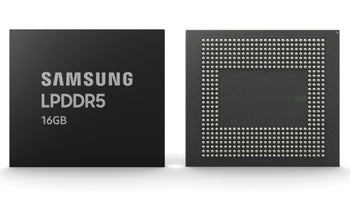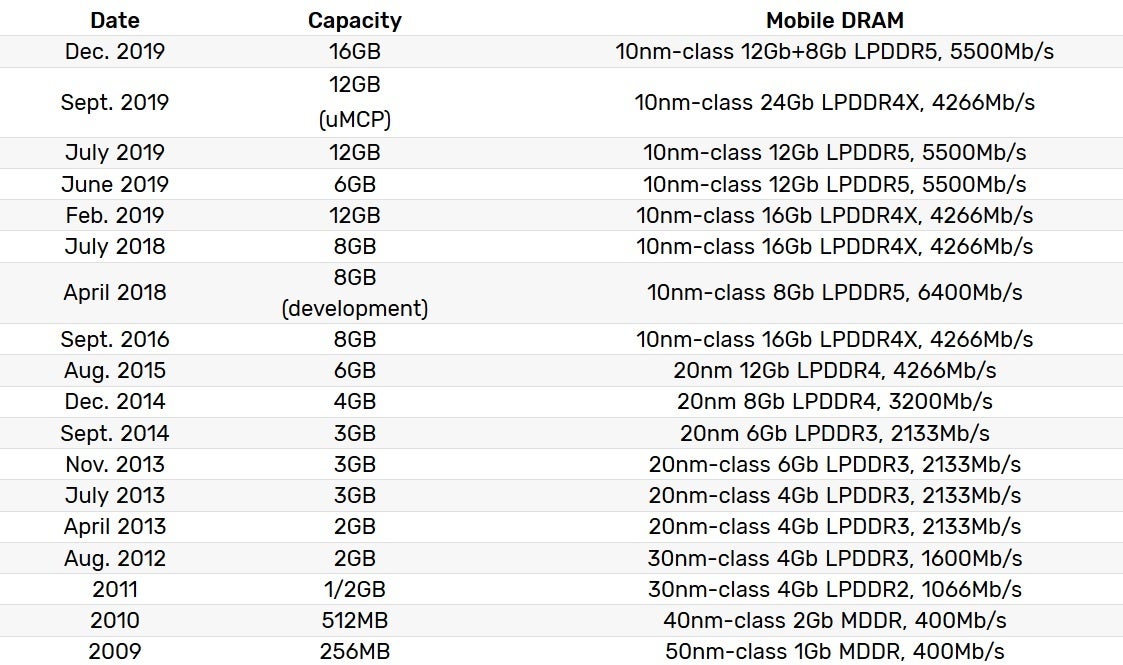Samsung starts production of an important Galaxy S20 Ultra 5G component

It wasn't that long ago when 4GB of memory was the standard for flagship Android smartphones. These days, it isn't unusual for a flagship to sport 12GB of memory and the 512GB Samsung Galaxy S20 Ultra 5G features 16GB of memory. Today, Samsung announced that it has started mass production of the mobile industry's first LPDDR5 DRAM package containing 16GB of memory. The package, used on the Galaxy S20 Ultra, is made up of eight 12Gb chips and four 8Gb chips all manufactured by Sammy's own foundry using its second-generation 10nm process.
According to Samsung, the new 16GB DRAM package will "lead the premium mobile memory market with added capacity that enables enhanced 5G and AI features including graphic-rich gaming and smart photography." The LPDDR5 DRAM packages transfer data at a rate of 5,500 megabits per second (Mbps), 1.3x faster than the transfer rate of 4266Mbps achieved with Samsung's LPDDR4X DRAM packages. The 16GB LPDDR5 package provides a 20% energy savings and twice the capacity of an 8GB LPDDR4X system.
Samsung will release a new version of its 16GB DRAM package with a 17% faster transfer rate during the second half of the year
Cheol Choi, Samsung's senior vice president of memory sales & marketing, says, "Samsung has been committed to bringing memory technologies to the cutting edge in allowing consumers to enjoy amazing experiences through their mobile devices. We are excited to stay true to that commitment with our new, top-of-the-line mobile solution for global device manufacturers. With the introduction of a new product lineup based on our next-generation process technology later this year, Samsung will be able to fully address future memory demands from global customers."

The highest-priced version of the Galaxy S20 Ultra 5G includes Samsung's new 16GB DRAM package
Samsung says that the industry's largest DRAM package provides twice the memory as the capacity found on many high-end laptops and gaming-focused PCs. And speaking of games, the LPDDR5 16GB DRAM package helps users experience a higher level of responsiveness and enjoy "ultra-high resolution graphics" when playing mobile games.
The manufacturer will improve the specs of this package during the second half of this year when it starts to manufacture the chips used for the 16GB LPDDR5 DRAM package with its third-generation 10nm process. This will bump the data transfer speed by 17% to 6400Mbps. For those unaware, the process number represents how many transistors can fit inside an integrated circuit (IC). The smaller the process number, the more transistors there are inside the IC; a chip with a higher number of transistors will usually provide faster performance using less energy. As a comparison, the Snapdragon 865 Mobile Platform is produced by TSMC (the world's largest independent foundry) using its 7nm process. The A14 Bionic, which will be produced during the second half of this year, will be manufactured using the 5nm process.
Right now, Samsung and TSMC have roadmaps that take their chip manufacturing down to the 3nm process. To show you what the future might hold, consider that the 7nm Apple A13 Bionic SoC, produced by TSMC, carries roughly 8.5 billion transistors in each chip. The A14 Bionic, which will be produced using the 5nm process, will reportedly be stuffed with 15 billion transistors in each chipset.
To show how far Samsung and the mobile industry have come, the company included a chart that shows the history of its DRAM offerings that started in 2009 with the 256MB capacity package that was produced using a 50nm 1Gb DRAM chip featuring a data transfer rate of 400Mbps. By December 2014, Samsung was producing a 4GB capacity package that employed an LPDDR4 8Gb 20nm chip that transferred data at 3200Mbps.
Back in September of last year, Samsung produced a 12GB capacity DRAM package that used the LPDDR4X 24Gb DRAM chip made using the 10nm process. By the way, the LPDDR acronym stands for Low-Power Double Data Rate and as you might have guessed, LPDDR5 is faster and uses less energy than LPDDR4 chips.

Samsung's graph shows how far its DRAM chips have come in over 10 years










Things that are NOT allowed: